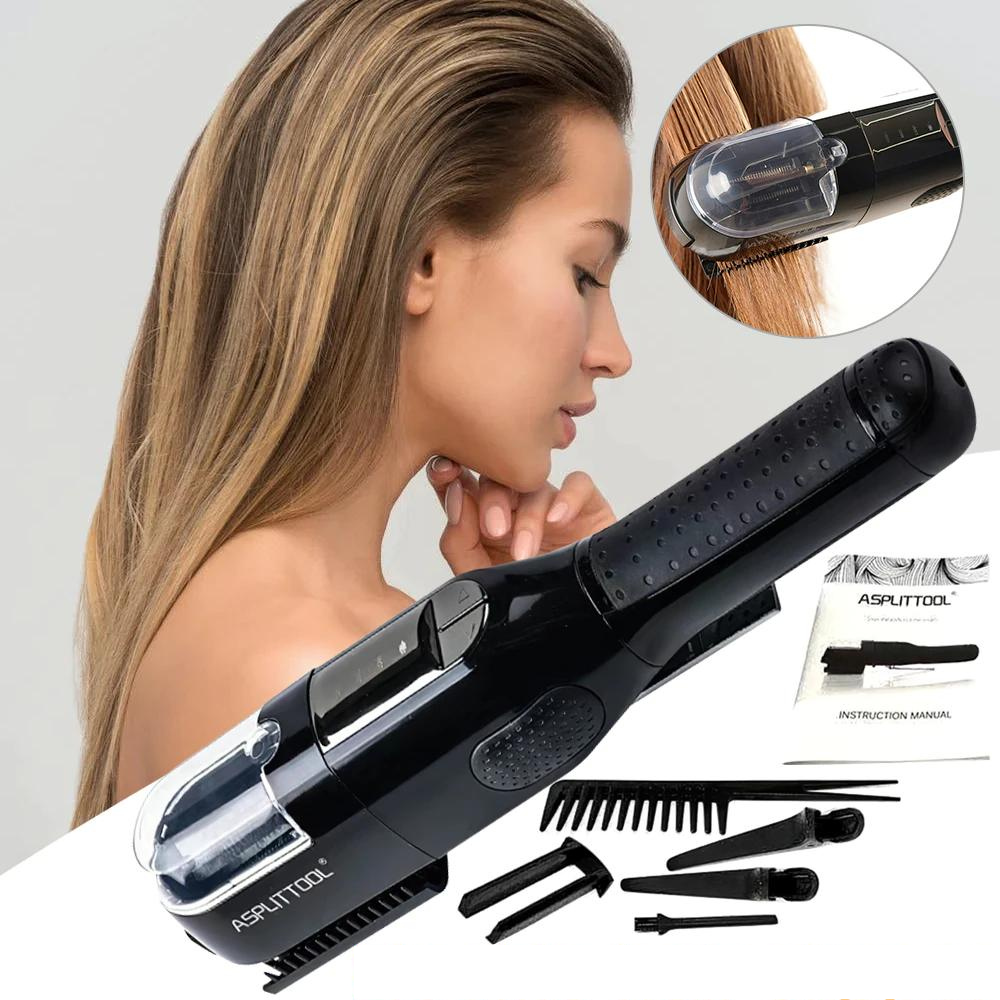Among all the problems related to curly hair which require constant attention, split ends are at the top of the list. They have an impact on the appearance and general health of each type of loops .
In addition to frequent hydration management including curly hair need, processing and verification of split ends should be a regular practice to prevent curls from breaking and frizzing.
There are a number of reasons why forks on the curly hair occur. And while there are temporary solutions to help fix them, the ultimate goal is to eliminate them completely.
The management of split ends on curly and frizzy hair takes a little work and patience, but in the long run, if you can get a handle on your damaged hair and figure out how to fix split ends, your hair will look much better and more comfortable to live with.
WHAT CAUSES SPLIT ENDS ON CURLY HAIR?
Take a few hairs and look closely at their ends under a lamp. You may notice small " Y " shaped pieces on the ends , an irregularity that looks like a shaft with branches coming out from the sides, hair that appears thinner or shorter than others, or a single hair that is literally split down the middle.

There may also be the appearance of Fairy Knots . Fairy knots are tiny, stubborn knots that form in hair strands, most commonly in natural, frizzy, kinky, and curly hair.

THE fairy knots are created when the ends of your hair split and then tangle on themselves. While all hair textures are at risk of their split ends becoming tangled, curly hair is particularly susceptible because it naturally curls into itself.
These are all signs of split ends , which can result from a number of styling practices, such as excessive blow-drying or flat ironing.
Using too much or too high heat can cause hair to dry out. And in the case of curly hair, this loss of moisture weakens each strand, making it brittle and susceptible to division.
Even if you don't heat your hair, your hair's porosity, not hydrating it enough, or using the wrong cleaning and styling products can lead to the same level of dryness and hair damage as a person who applies heat.
Some chemicals used in coloring processes, such as dyes and bleaches, can also cause dryness. Additionally, alcohols in styling products and sulfates in shampoos are also culprits that can dehydrate hair — and dehydration of strands is one of the many causes of hair loss. split ends .
Another cause is sleeping on cotton pillowcases or without a satin bonnet or scarf. There friction that occurs when your hair rubs against rough fabrics can leave hair broken, especially at the ends of each strand, which is the oldest and often driest part of your hair.
Just like the friction caused by certain materials, a similar effect can result from improper detangling and brushing of curly hair . Raking strands with the wrong tools or not knowing how to brush them curly hair can be damaging. The best way to avoid creating split ends is to make sure the hair is sufficiently slippery and hydrated before brushing it with a tool. Additionally, whenever possible, it is best to avoid brushing dry curls.
IS CURLY HAIR MORE PRONE TO SPLIT ENDS?
Curls, which are already prone to dryness, can to fray at the ends more often than other textures, simply because of the way a strand curls. Natural textures are more vulnerable to split ends where the strand curls. These bends are weaker than other parts of the hair and make it more difficult for natural hair oils to penetrate each strand.
HOW TO NO LONGER HAVE FORKS?
Put an end to split ends may require some work initially. It may seem a little daunting, but all it takes is a few changes to your natural hair care routine and a few style changes to get things under control.
Change your shampoo. Start by checking your shampoo's ingredient labels. Anything containing sodium lauryl sulfate (SLS or sulfates) should be replaced with a non-drying cleanser, like Monoi Sulfate-Free Restorative Shampoo.
If your hair is particularly dry due to seasonal changes, such as frequent sun exposure or time spent in an indoor heater during the winter, reduce your shampoo use. Instead, use Sacred Tiare Strengthening Conditioner in place of your shampoo every other wash day.
Constantly condition your hair. When it comes to conditioner, this is the step in your routine that you should spend the most time on. By constantly rehydrating your hair, you will keep it smooth, friction-free and split-end free.
Try a regular rinse-out formula made with hair oils, like Goddess Strength Strengthening Conditioner, which contains castor oil to strengthen strands and seal in moisture and nutrients needed by curly textures. By using it regularly, you will begin to notice softer, more hydrated natural hair.
Treat thoroughly every month. In addition to traditional conditioners, curls benefit greatly from hair treatments and masks that deeply hydrate. Ingredients such as glycerin and coconut oil, found in the Monoi Inner Strength System, help rehydrate and strengthen the hair more intensively.
It is this reinforcement of each strand which will prevent afro hair from breaking easily when stresses like friction come into play. For an even more effective deep treatment, pair the Coco Creme Anti-Curl Deep Hydration Mask with a steamer, which will allow the ingredients to be better absorbed by each strand.
Get your hair cut regularly. Having split ends is like facing a race in a pair of socks. If you don't stop it in its tracks, it will continue.
In cutting the ends of your hair where split ends are present, you will prevent fraying from moving further up the hair shaft. Try trimming your ends every six weeks or so, or talk to your curl specialist to determine the right cadence for your trims.
To cut the ends of hair , you can use the hair tip cutting machine also called fork cut:

Sleep well. As we mentioned, bedtime habits without a scarf or bonnet can be very damaging to natural hair in the long run. You may not notice it right away, but the constant friction raises the hair cuticle , which, for dry and damaged hair, exposes it to moisture loss, breakage and split ends.
Get a satin or silk bonnet and pillowcase to reduce friction and prevent your hair's natural oils from being sucked into the fabric. Also consider applying a moisturizer, like Black Vanilla Moisture & Shine Hair Smoothie, before bed to rehydrate your hair while you sleep.
Practice protective styling. Another easy way to keep curly hair under control while you sleep is to twist or braid it into a protective style. You can keep the ends of your hair out of the way to minimize friction and pulling.
The same rules apply when wearing hats and accessories. Use a hydrating pomade, like Hair Milk Nourishing and Conditioning Styling Pudding, to add moisture and hold to your protective style.
How you remove your protective hairstyle is just as important as how you install it. It may take a little more work to patiently untie and remove your braids, twists, or wig, but gently combing your hair from the ends up will help prevent breakage and other hair problems.
HOW TO FIX SPLIT ENDS OF CURLY HAIR?
The most effective way to repair split ends of curly hair is to get rid of it completely. Go to your hairdresser to have the split ends cut. If not cut completely, the hair will continue to fray where it parts.
Eventually, the bit will no longer be repairable and will likely break. Another solution is to use a butter or oil-based product, like Coco Creme Curl Shaping Gel Cream with Coconut Oil, to temporarily smooth and seal the curls. split ends of curly hair.
Step up your efforts to repair your damaged hair with this tip sheet on how to stop hair breakage.



